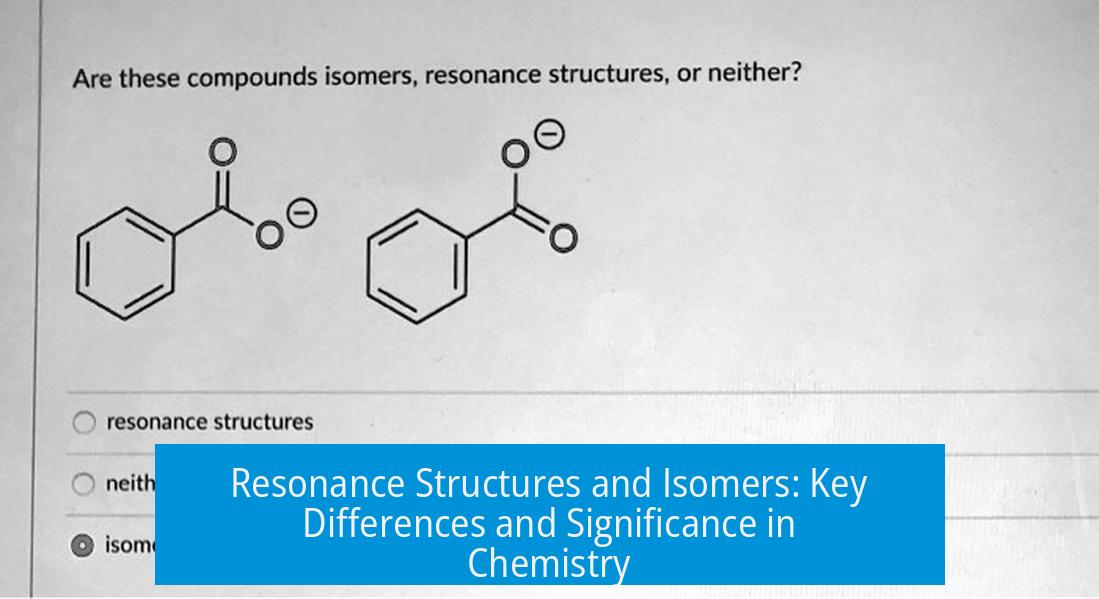Resonance Structure vs. Isomers
Resonance structures and isomers both describe different ways atoms and electrons can be arranged in molecules, but they represent fundamentally different chemical concepts. Resonance structures are multiple Lewis drawings of the same molecule showing possible electron arrangements, while isomers are distinct molecules with the same molecular formula but different connectivity or spatial orientations.
What Are Resonance Structures?
Resonance structures depict electrons shifting within a molecule without changing the positions of the atoms. They reveal that a molecule does not have a single fixed electron distribution but rather a hybrid of several contributing forms.
Key Characteristics of Resonance Structures
- Electron movement only: Resonance involves shifting electrons (usually pi or lone pair electrons) without breaking or forming bonds.
- Octet rule obeyed: No breaking of the octet rule occurs, ensuring valid Lewis structures.
- Same atomic framework: The atom connectivity stays identical across all resonance forms.
- Weighted average: The real electronic structure is an average of these resonance contributors, not any single one.
- Clarifies chemical behavior: Resonance helps explain acidities, reactivities, and sites prone to reaction that are not obvious in a single Lewis structure.
For example, the nitrate ion (NO3−) is best described by three resonance structures where the double bond shifts among the oxygens. The actual molecule’s bonds are equivalent and of intermediate length, reflecting resonance stabilization.
What Are Isomers?
Isomers are distinct molecules with the same molecular formula but different atomic connectivity or spatial arrangements. Unlike resonance forms, isomers usually do not interconvert spontaneously and represent separate chemical entities.
Main Types of Isomers
- Constitutional (Structural) Isomers: Different bonding patterns among atoms but identical formulas. Example: Propanol and isopropanol differ in the connectivity of their carbon chain despite sharing C3H8O.
- Stereoisomers: Same bonds but different spatial arrangement. Includes enantiomers and diastereomers. Example: Ibuprofen has one stereocenter where the configuration affects its biological activity.
Details on Stereoisomers
- Enantiomers: Molecules that are non-superimposable mirror images, differing at all stereocenters.
- Diastereomers: Molecules with at least one stereocenter the same but others differ; they possess distinct physical properties.
Cis-Trans Isomers
These are stereoisomers that arise from restricted rotation, commonly in alkenes or cyclic structures:
- Cis isomers: Substituents of interest are on the same side.
- Trans isomers: Substituents are on opposite sides.
This nomenclature is derived from Latin, where “cis” means “on this side,” and “trans” means “across” or “on the other side.”
Chair Conformations in Cyclohexane Derivatives
The chair form better represents cyclohexane ring dynamics. Cyclohexane undergoes ring flips between chair and boat confirmations. Substituents prefer the equatorial position due to lowered steric hindrance compared to the axial position. For instance, cyclohexanol commonly has its OH substituent in the equatorial position, representing a more stable geometry.
Comparing Resonance Structures and Isomers
| Aspect | Resonance Structures | Isomers |
|---|---|---|
| Definition | Multiple electron arrangements for the same molecule | Distinct molecules with same formula but different connections or geometry |
| Electron Movement | Electrons shift, atom positions fixed | Atoms arranged differently; electrons bound accordingly |
| Bond Changes | No bonds are broken or formed | Bonds differ (constitutional) or same bonds oriented differently (stereoisomers) |
| Interconversion | Resonance forms contribute simultaneously; molecule is hybrid | Generally stable and separate species, do not interconvert without reaction |
| Examples | Nitrate ion resonance, benzene resonance | Propanol vs. isopropanol, R- and S- ibuprofen |
Significance in Chemistry
Resonance structures improve our understanding of bonding and reactivity: They explain electronic delocalization, contribute to molecular stability, and influence acidity, basicity, and electrophilic/nucleophilic sites. This concept is vital for interpreting conjugated systems, aromaticity, and charge distributions.
Isomers explain the diversity of molecules sharing chemical formulas: Structural isomers can differ significantly in physical and chemical properties. Stereoisomers and their subtypes impact biological activities, flavors, fragrances, and pharmaceutical effects, making stereochemistry crucial in medicinal chemistry.
Practical Applications
- Resonance: Helps chemists predict reaction mechanisms and explain unexpected stability, like in aromatic compounds or carboxylate ions.
- Isomers: Used in drug design to produce active forms of medications with fewer side effects. For example, the R-enantiomer of ibuprofen has anti-inflammatory effects, unlike the S-enantiomer.
Key Takeaways
- Resonance structures illustrate alternate electron placements within the same molecule without changing atomic positions.
- The actual molecule is a hybrid, combining resonance contributors into a single stable structure.
- Isomers are separate molecules with the same formula but different connectivity or 3D geometry, including constitutional and stereoisomers.
- Isomers generally do not interconvert easily and represent distinct chemical species.
- Understanding both concepts is essential for interpreting molecular behavior, stability, and function.
What distinguishes resonance structures from isomers?
Resonance structures involve different electron arrangements within the same molecule without changing bonds. Isomers are distinct molecules with the same formula but different bonding or 3D structures.
Can resonance structures interconvert like isomers?
No, resonance structures do not interconvert as separate entities. They represent a hybrid electron distribution. Isomers rarely convert to each other under normal conditions.
Why can’t bonds break or form in resonance structures?
Resonance only moves electrons to better represent molecule behavior. Bonds stay fixed to obey the octet rule and keep the molecule’s identity unchanged.
How do stereoisomers differ within isomers?
Stereoisomers have the same bonds but differ in 3D spatial arrangement. This affects their physical properties and biological activity, like R and S forms of ibuprofen.
What is the role of chair conformations in cyclohexane isomers?
Chair conformations show cyclohexane’s stable 3D shape. Substituents prefer equatorial positions due to steric effects, influencing energy and molecule behavior.





Leave a Comment